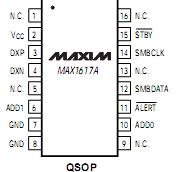Features: Two Channels: Measures Both Remote and Local Temperatures
No Calibration Required
SMBus 2-Wire Serial Interface
Programmable Under/Overtemperature Alarms
Supports SMBus Alert Response
Supports Manufacturer and Device ID Codes
Accuracy
±2°C (+60°C to +100°C, local)
±3°C (-40°C to +125°C, local)
±3°C (+60°C to +100°C, remote)
3µA (typ) Standby Supply Current
70µA (max) Supply Current in Auto-Convert Mode
+3V to +5.5V Supply Range
Small 16-Pin QSOP PackageApplication-Desktop and Notebook
-Central Office
-Computers
-Telecom Equipment
-Smart Battery Packs
-Test and Measurement
-LAN Servers
-Multichip Modules
-Industrial ControlsPinout SpecificationsVCC to GND.................................................................-0.3V to +6V
SpecificationsVCC to GND.................................................................-0.3V to +6V
DXP, ADD_ to GND...........................................-0.3V to (VCC+ 0.3V)
DXN to GND...............................................................-0.3V to +0.8V
SMBCLK, SMBDATA, ALERT, STBY to GND.......-0.3V to +6V
SMBDATA, ALERT Current.................................-1mA to +50mA
DXN Current...........................................................................±1mA
ESD Protection (SMBCLK, SMBDATA,
ALERT, Human Body Model)............................................4000V
ESD Protection (other pins, Human Body Model)....................2000V
Continuous Power Dissipation (TA= +70°C)
QSOP (derate 8.30mW/°C above +70°C)..........................667mW
Operating Temperature Range...........................-55°C to +125°C
Junction Temperature.........................................................+150°C
Storage Temperature Range..............................-65°C to +165°C
Lead Temperature (soldering, 10sec).................................+300°CDescriptionThe MAX1617A (patents pending) is a precise digital ther-mometer that reports the temperature of both a remote sensor and its own package. The remote sensor is a diode-connected transistor-typically a low-cost, easily mounted 2N3904 NPN type-that replaces conventional thermistors or thermocouples. Remote accuracy is ±3°C for multiple transistor manufacturers, with no calibration needed. The remote channel can also measure the die temperature of other ICs, such as microprocessors, that contain an on-chip, diode-connected transistor.
The 2-wire serial interface accepts standard System Management Bus (SMBus®) Write Byte, Read Byte, Send Byte, and Receive Byte commands to program the alarm thresholds and to read temperature data. The data format is 7 bits plus sign, with each bit corresponding to 1°C, in two's complement format. Measurements can be done automatically and autonomously, with the conversion rate programmed by the user or programmed to operate in a single-shot mode. The adjustable rate allows the user to control the supply-current drain.
The MAX1617A is nearly identical to the popular MAX1617, but has improved SMBus timing specifications, improved bus collision immunity, software manufacturer and device identification available via the serial interface, and a power- on reset function that can force a reset of the slave address via the serial interface.

 MAX1617A Data Sheet
MAX1617A Data Sheet







